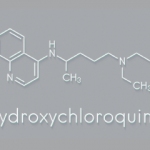
ShutterDivision / shutterstock.com
CHICAGO—As good an option as hydroxychloroquine (HCQ) is for many patients with rheumatic diseases, such as rheumatoid arthritis and especially lupus, safety must be an important consideration, an expert said at this April’s ACR State-of-the-Art Clinical Symposium.
The use of the antimalarial has become a controversial subject, with clinicians trying to balance the drug’s disease-modifying effects with concerns about toxicity to the retina that can impair vision in patients on high and long-term doses. Some rheumatologists worry recommendations issued in 2016 by the American Academy of Ophthalmology (AAO) call for too much caution, possibly at the expense of treatment efficacy.
James Rosenbaum, MD, wears both hats: He’s chair of arthritis and rheumatic diseases at Oregon Health & Science University, and chief of ophthalmology at Legacy Devers Eye Institute in Portland, Ore. In his talk, he said the safety concerns are not meant to curb use of HCQ. He held out acetaminophen as an example: It’s a great drug, but it’s also the top cause of liver toxicity in the U.S., so its use shouldn’t go unchecked.
“It’s a wonderful, wonderful drug—I just want you to use it more safely,” he said, referring to HCQ. “The antimalarial is unique in that it is one of our very few medications that can affect the immune response without impairing the immune response.”
The Research Says
Research has found that patients with stable lupus who stopped their HCQ were more likely to flare over the next six months and to require corticosteroids, Dr. Rosenbaum said. More recently, researchers have also found HCQ could add effectiveness to the primary prevention of cardiovascular events in lupus patients, he noted.1
The 2016 recommendation update by the AAO on HCQ use was based on findings published in 2014 that found the risk of toxicity increased with dosage and duration, and identified other risk factors for toxicity.2
Risk Calls for Monitoring
“If you are taking a higher dose for longer than 20 years, that toxicity is exceeding 50%,” Dr. Rosenbaum said.
The AAO recommendations lists as “major risk factors” a daily dose of more than 5 mg/kg, more than five years of use if a patient has no other risk factors, renal disease and tamoxifen use. Although it’s not known for sure whether diabetic retinopathy or macular degeneration increase the risk of toxicity, the guideline warns they could complicate toxicity monitoring.
The recommendation calls for screening shortly after starting the drug. No more screening is recommended for the next five years. After that, yearly screening is recommended. The most important screening tests, he said, are the automated visual field test and the spectral domain optical coherence test.
The guideline writers were careful to say the goal isn’t to “stop [this] valuable drug at the first borderline abnormality, but to recognize definitive signs of toxicity at an early enough stage to prevent a loss of visual acuity.”
Dr. Rosenbaum said the ACR’s position statement on screening for HCQ retinopathy is too vague. The statement says patients should have baseline exams “over the duration of therapy,” and that the exam should “take advantage of technologies with the potential to detect retinopathy before patients recognize visual loss.”
Dr. Rosenbaum said the safety concerns [described by the 2016 recommendations issued by the American Academy of Opthalmology] are not meant to curb use of hydroxychloroquine.
Risk vs. Benefit
In a question-and-answer session after the talk, an exchange between Dr. Rosenbaum and Michelle Petri, MD, MPH, director of the Johns Hopkins Lupus Center in Baltimore, illustrated the tensions that can exist over HCQ safety in lupus patients.
“We have no alternative to Plaquenil [HCQ],” Dr. Petri said. “It would be one thing if there was an alternative. And right now Plaquenil is the only drug we have where we have proof from multiple studies that it improves survival. Plaquenil is the only drug we have that reduces later lupus nephritis, reduces later CNS [central nervous system] lupus and reduces thrombosis from the antiphospholipid antibodies. So who proved that this lower dose works?”
“That’s true, but I don’t think the burden should be on the ophthalmologist to prove the efficacy,” Dr. Rosenbaum said. “The burden should be on us as rheumatologists to demonstrate the efficacy.”
“But we will not have those studies if we all obey this new dosing, now will we?” Dr. Petri said. “Why don’t we personalize? Are we going to treat everybody with lupus the same way based on these guidelines? We don’t do that with any other lupus rule. The advantage to rheumatology is we all feel comfortable with personalizing.”
“Let’s say your ophthalmologist reports to you that the OCT [optical coherence tomography] is abnormal,” Dr. Rosenbaum said. “I’m disturbed any ophthalmologist would say, ‘It’s my responsibility to terminate the drug that’s being prescribed by another physician.’”
“It happens all the time,” Dr. Petri said.
Dr. Rosenbaum called it a “classic risk–benefit analysis.”
“The OCT and the [automated visual field tests] are complementary,” he said. “Some patients may have mild field changes and a normal OCT, and some patients may have an abnormal OCT and a normal field. It doesn’t necessarily mean you have to stop the drug. But in my opinion, it certainly means you have to inform the patient and discuss with the patient that there’s an additional risk. … And depending on how valuable you think the medication is, you and the patient need to make a decision together.”
Thomas R. Collins is a freelance writer living in South Florida.
References
- Fasano S, Pierro L, Pantano I, et al. Longterm hydroxychloroquine therapy and low-dose aspirin may have an additive effectiveness in the primary prevention of cardiovascular events in patients with systemic lupus erythematosus. J Rheumatol. 2017 Jul;44(7):1032–1038.
- Marmor MF, Kellner U, Lai TY, et al. Recommendations on screening for chloroquine and hydroxychloroquine retinopathy (2016 revision). Ophthalmology. 2016 Jun;123(6):1386–1394.



